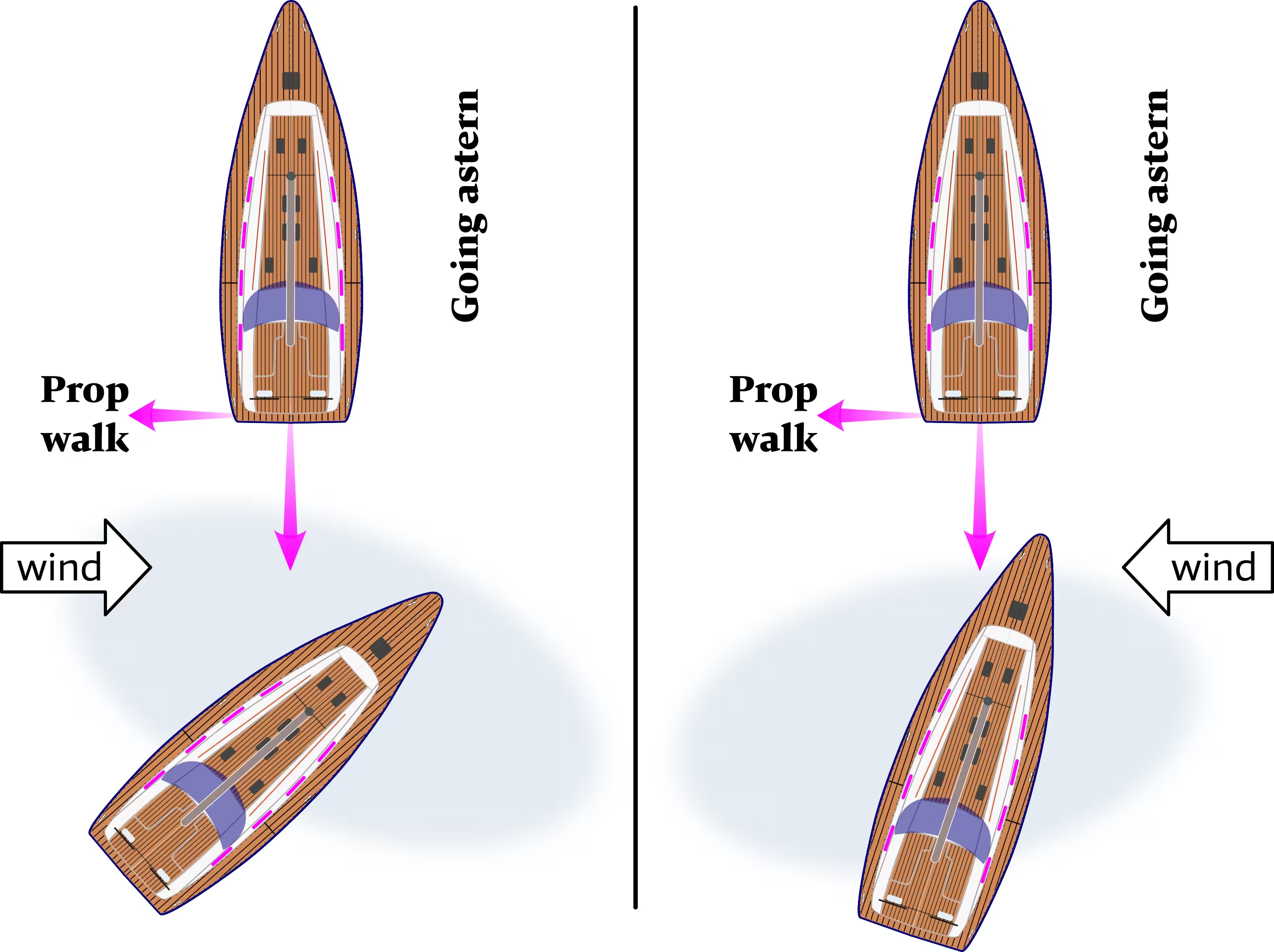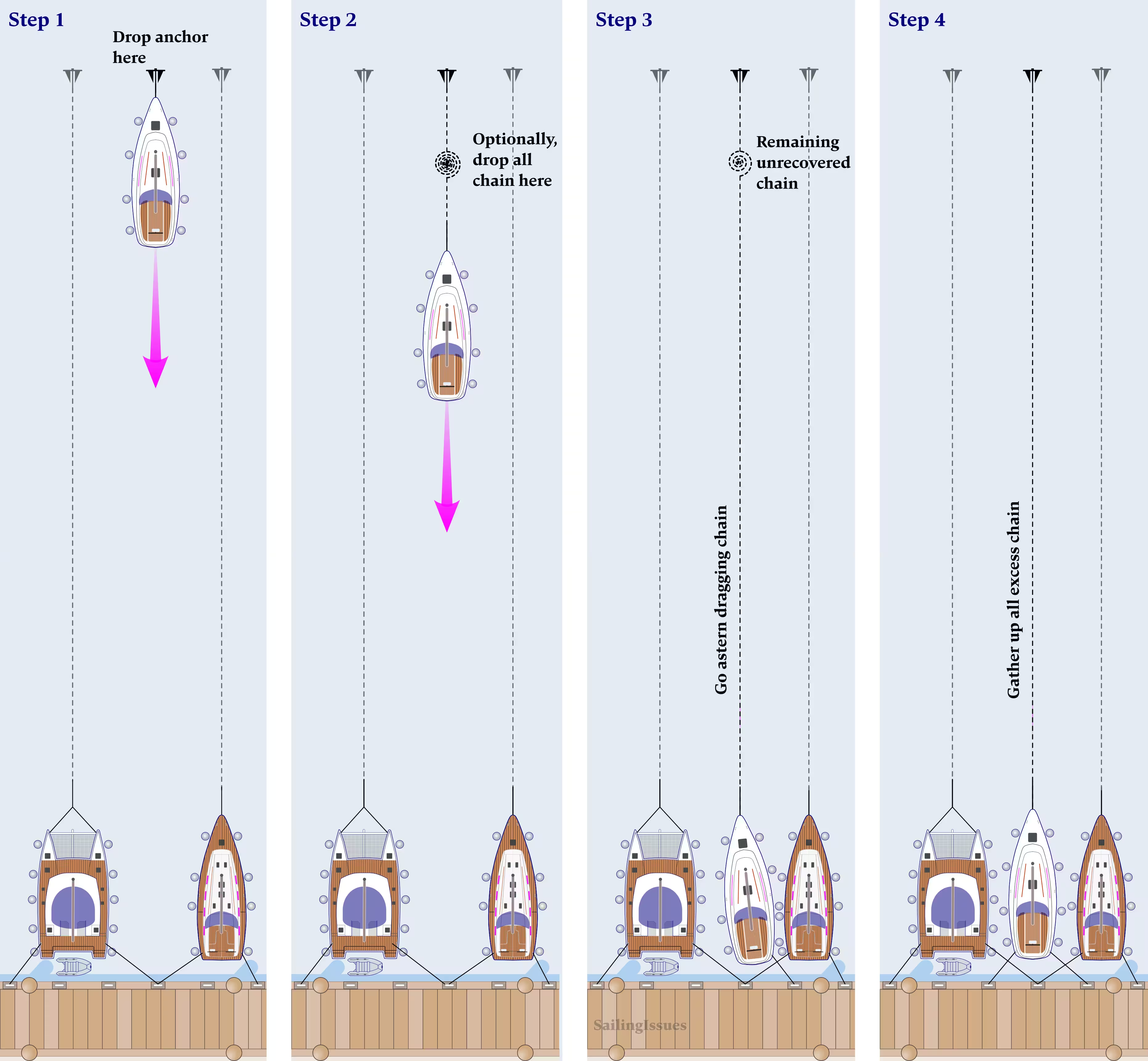Mediterranean mooring
The Mediterranean mooring technique – often shorted to “Med mooring” – is a common practice in the Mediterranean Sea where there is often little room in combination with significant depths, taking advantage of a neglectable tidal range.
Rather than coming alongside a slip or pier beam-to, boats tie stern-to, at a right angle to the quay or dock.
Consequently, yachts in the Mediterranean are equipped with electric anchor windlasses and lenghty all-chain anchor rodes. Not only the anchor but also the heavy all-chain rode will keep the yacht's bow in place.

On the approach of the quay, pull in slowly until you identify an open space.
Then pivot the yacht and back in toward the dock and lower the anchor and pay out rode, or grab a fixed line and let it out as you back in.
Remember to have fenders ready all around, plus one that can be quickly placed where needed.
Advantages of med mooring
- Any wash of ferries, changes of wind direction, any swell entering the bay, gusts, etc. will be cushioned by the catenary curve of the anchor chain which will keep the yacht clear of the quay; in contrast, berthing along-side won't protect the yacht.
- In the Mediterranean – notably in Greece – berthing along side is often hampered by blocks of ballasting near the quay.
- No neighbouring crews walking on your deck greatly adds to your privacy, especially so if bows-to.
- Some islands in the Mediterranean are home to rats, cockroaches, etc.
Mediterranean mooring (with the gangway raised well above the quay) helps prevent vermin getting on board.
Note that you should raise the gangway anyway, to allow for the pitching motion due to waves / swell. - It is much easier to leave a (crowded) port. No skipper likes to be the innermost yacht – four yachts thick – in an along side mooring situation (AKA “rafting up”).
Stern-to or bows-to
As the bow anchor typically offers more holding power and a longer (heavier) anchor chain it is very useful to become an expert in the stern-to variant of berthing Mediterranean-style.
However, in shallow waters the bow-to approach will keep the rudder safe, so keep this alternative in mind, also for added privacy.
Mediterranean mooring manoeuvre
- Position the bow the full length of your anchor chain away from the quay berth, or with less room as far as possible, ready to drop anchor.
In a crosswind start with the yacht a bit upwind so that by the time the anchor touches the seabed you will have drifted into the right spot. - Drop anchor in front of the spot on the quay you are aiming for. Note, that anchoring NOT perpendicular to the quay (as people often do in a crosswind), could well mean crossing and potentially fouling the anchor lines of your neighbours. More pertinently, the wind could be blowing from another direction later. Place your anchor at a right angle to the quay at the intended berth.
- Just before the anchor reaches the seabed, put the engine in reverse. Maintaining speed helps you to manoeuvre, and moving astern also prevents fouling the anchor with its own chain. Moreover, if there is room, proceed with a gentle one knot speed in reverse, before dropping the anchor:
- less chance the anchor will foul.
- less drifting out of position in case of crosswind.
- the anchor will often set earlier which means a greater distance from quay, maximising the scope.
You should veer out as much anchor chain as possible.
With 80 metres of chain, start at 100 metres from the quay. The anchor will likely require an odd 25 metres to set properly.
Prop walk
With the engine in reverse, the “prop walk” will steer the yacht's bow to starboard by pushing the aft to port, if the the propellor is right handed.
The majority of propellers are “right-handed”, meaning that they turn clockwise, looking forward, when in forward gear.

Note this is with a right-hand prop, while going astern with the engine in reverse (and not in neutral).
With wind to port side, the prop walk and wind forces work in the same direction.
With wind to starboard the forces are opposing; prop walk will usually win, except in higher winds.
Crucially, this is only happens when the engine is in reverse gear and not if it is in neutral. First make speed and counteract the prop walk as much as possible by putting the rudder at 45 degrees (more will only brake), then put the engine in neutral and the yacht will listen to the rudder normally.
To find prop walk – run the engine astern with the yacht moored. With prop wash (water turbulence) to starboard it means that the stern kicks to port when going astern.

1) Start reversing a long way from the berth. As you gather speed astern you can put the engine in neutral (especially in puffs). Without prop walk the yacht will turn less and you have more control.
2) Use a bit of tension on the chain to prevent the bow swinging away to starboard.
Succesful Mediterranean mooring

Step 1) If you have that option, choose for wind on port side. Drop anchor at right angles to the jetty or quay, and at maximum length. Then start reversing towards the intended berth.
Step 2) Drop all chain after a few boat lengths (cockpit in control; short-handed sailing). Alternatively, ease out the chain while going astern with the engine, the chain will counteract (most of) the prop walk and keep the bow pointing toward the anchor.
Step 3) The remaining pile of chain (or easing out of chain) will prevent the yacht drifting to leeward. Once near the jetty or quay tie up to a yacht (if present). Use the windlass to collect up the surplus chain that is still sitting on the sea bed.
Step 4) When the yacht is in position, first tighten the anchor chain, then bring the leeward mooring line ashore. If you don't see any lines or debris in the water, and have a fender at the stern, apply full throttle in reverse to check the anchor.
Lengths of chain not to scale.
- The crew on the foredeck should put a mild tension on the anchor line, while the yacht reverses, to help the anchor dig deeper. Not too much, since you would lose speed and also the anchor could break out; the foredeck is has command over the anchor – communication with the helsperson is vital.
- Another method (to be used with inexperienced crew or if you are sailing solo) is to drop most or all of the anchor chain after having reversed a few boat lengths. The helmsperson is in full control.
- The crew on the foredeck should put a mild tension on the anchor line, while reversing, to help the anchor dig deeper. Not too much, since you would lose speed and also the anchor could break out.
- Near the quay there is an increased risk on fishing nets, loose lines and other rubble, so it is good practise not to use the prop the last few metres. Braking by feeding the anchor less line works better also helps the anchor set firmly.
- Place a crewmember with a roving fender on either side, but with strong port side wind, place both on the leeward side.
- “Dipping the eye” refers to the proper etiquette of attaching more than one hawser (mooring line) to a single bollard or cleat, so that each can be lifted off without disturbing the other(s). The second hawser is passed under the first, then up through the eye of the first (hence the name), before being secured over the bollard.

Place your mooring line from underneath the lines that are already present.
Orange came first, then green and you are blue!
This way the other yachts can leave easier.
This should also be done with cleats. - With one line on shore (windward one if cross wind), it is time to put pressure on the anchor: take anchor chain in till the catenary curve becomes more of a straight line. If after a while (sometimes immediately) the catenary curve reappears, your anchor has not set… by the time you have winched one third of the anchor line back on board, start considering a second attempt.
Tip: Plan to arrive early (typically before 15:00) at the port of destination so that there is ample space to manoeuvre and lots of berths at the quay to choose from.
Long-line-ashore mooring method

Step 1) Drop anchor perpendicular to the mole, or shore (rocks or beach). Use the dinghy to bring a line ashore, this will become the windward mooring line.
Step 2) Drop all chain after a few boat lengths (cockpit in control). Alternatively, ease out the chain while going astern with the engine, the chain will counteract (most of) the prop walk and keep the bow pointing toward the anchor.
Use a cockpit winch to haul in the shore line.
Step 3) The remaining pile of chain (or easing out of chain) will prevent the yacht drifting to leeward. Once near the shore or mole also the mooring line will help control the yacht.
Step 4) When the yacht is in position, first tighten the anchor chain, then attach the leeward mooring line using the dinghy.
Taking lines ashore is a technique used mainly in Greece and Turkey, as well as some places in Croatia, where swing anchoring is not possible.
Lengths of chain not to scale: use as much chain as possible.